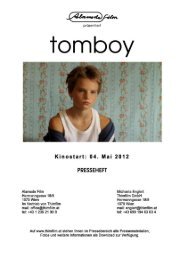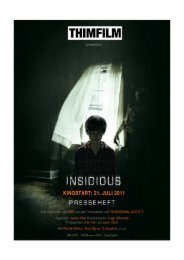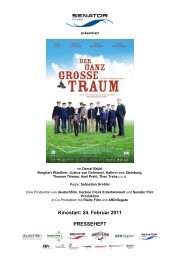Abbas Kiarostami - Thimfilm
Abbas Kiarostami - Thimfilm
Abbas Kiarostami - Thimfilm
- No tags were found...
You also want an ePaper? Increase the reach of your titles
YUMPU automatically turns print PDFs into web optimized ePapers that Google loves.
Back then I asked him why he wanted to make a film in Japan and thiswas his reply:- “Well, because if I make a film in Japan I won’t be accused of makinga film for the West. Making a film in Japan is like making a film in Iran.Whether actors speak Japanese or Persian, there are still subtitles.”This conversation is a good introduction to one important aspect in ourrelationship: language. Or to be more precise, the spoken word. I don’tspeak English. He doesn’t speak French. I don’t speak Persian. So how dowe communicate? This is something quite miraculous and very interesting.It is also a theme in the film Like Someone In Love. Sometimes, we traveltogether without an interpreter and we manage to understand one another.How? I speak to him in French rather slowly, and he speaks back to me inEnglish. I manage to understand his English and he manages to understandmy French. Specially when we are in a car together and I’m driving.He sits next to me, and we speak to each other. We can communicatewith each other because the relationship we have is based on more thanjust words. The words carry information but they also carry an intention,something along the lines of a mutual understanding, a universal language.The situation was the same when working with the filmmaker Kieslowski.I didn’t speak Polish. He didn’t speak French. So I spoke bad Englishand he spoke bad English…..With him, our conversations never tookplace in the car, but in bars, where we would drink together, and itworked. I found the very same universality that goes beyond the barrierof language. I’m not talking about a common language like Esperanto,it goes further than that, it is about being on the same wavelength.On Certified Copy, I remember we were working as we often did at theediting desk, just after the first run through. I commented on a sequencethat I felt was a bit long. He cut it out and I suddenly realised that this wasnow a different film. The 30 seconds that had been taken out changedthe film and changed the language. It changed <strong>Abbas</strong>’ style and hiscinematographic vocabulary: by introducing an ellipsis and omitting aportion of the sequence of events, we were giving emphasis to somethingthat shouldn’t be in the film at all. Certified Copy followed continuity inspace and time, like a long take. He purposefully cut out the sequence infront of me, thinking that maybe I was right, but it was clear that he wasright and I was wrong. It was this kind of thing that contributed to ourunderstanding of each other.What I find fascinating about <strong>Abbas</strong> is that he is always moving forward. His work is constantly evolving.This is the characteristic of a great artist. He approaches each film very differently to the last. When hemade Ten it corresponded to the arrival of the digital camera. For me, Ten is the first film that manages tocombine new digital technology with the subject in a coherent way. Breathless did the same in 1960 withthe revolutionary arrival of the hand-held camera, synchronised sound and carefully planned lighting.There was a link between new technology and Godard’s new way of writing. In the same manner,<strong>Abbas</strong> <strong>Kiarostami</strong> is one of the only filmmakers to have taken advantage of new digital technologyfor his mise-en-scene.For <strong>Abbas</strong> <strong>Kiarostami</strong>, the issue when making Like Someone In Love was not to forget himself once outsideof Iran. This was of great concern to me. I think that every artist is deeply rooted in the reality of his owncountry, but at the same time we expect them to be universal. One foot in, one foot out. How could wehelp prevent him from losing his way? How could he remain true to himself? He managed to achieve thiswith Certified Copy which is why I found it so surprising that the Americans and the Brazilians felt that itwas an Iranian film above all else. After having worked with a famous actress such as Juliette Binoche, forLike Someone In Love, he chose to work with newcomers, one of whom was 80 years old and the other20! By doing this, he was experimenting further with artistic expression and the complexity of relationships.Making his film in Japan forced him to write a script, a text. This created a distance between <strong>Kiarostami</strong>and his film, and a distance between himself and Iran. It automatically gave him the status of foreigner,which enabled him to get to the essence of the film more directly.There is a very interesting theme in Like Someone In Love that is worth exploring, the theme of reflections.Reflections create backdrops, new spaces, surprising mirrored images. I watched him work and take thetime to register the reflection of the stand-ins as they passed by. Working directly with the actors turnedout to be quicker than working with the stand-ins. A director experimenting with classic cinematographictraditions can be very trying for the film crew. There were regular run-ins during the early stages offilming. This working method also required readjustments to be made by the production team. We arecapable of becoming lazy, and never questioning our working methods. But <strong>Abbas</strong> <strong>Kiarostami</strong> is like analarm bell that wakes you up in the morning. It might not be pleasant, but you have to jump. Without him,I would be asleep! A Japanese film, produced in France has never been tried before. As Arte turneddown the film, I didn’t have enough money to produce it, even with the contribution from the Japaneseproducer. But I had promised <strong>Abbas</strong>. So I took a very beautiful Yves Klein sponge sculpture that I cherishalong to Sotheby’s who sold it for me in auction in the States. With the proceeds of the sale, I was ableto make <strong>Abbas</strong> <strong>Kiarostami</strong>’s film. I am happy to have swapped a beautiful piece of work by Yves Kleinfor a beautiful piece of work by <strong>Abbas</strong> <strong>Kiarostami</strong>.Just the other day I said to him:- “Who will you do your next film with?” He looked at me slightly taken aback.- “Well… with you of course. You are my only producer.”- “I’m so pleased, because you are my only director.”10 11
















